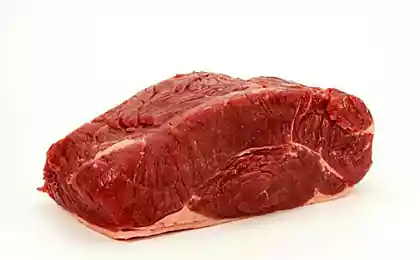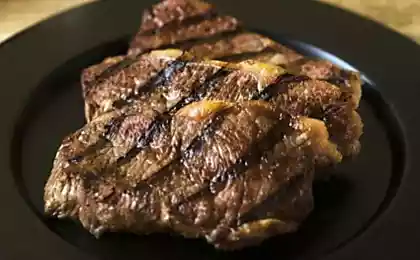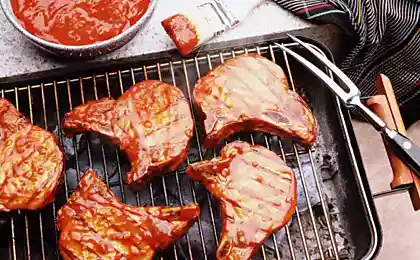1349
MEAT. Fundamentals of cooking meat over an open fire
here, a lot of letters, a lot of pictures (the end indicated, try not to delay)
Past May Day celebrations at last opened the season picnic and holiday pilgrimage, and with it, and cooking meat outdoors. Now, every weekend there will inevitably be accompanied by mass migration to suburban forest belts, smoke smelling clothes and indispensable reflection about the choice of a suitable meat, barbecue and firewood.
To make it easier to navigate in this difficult matter gastronomic, here you will learn about the history and methods of cooking meat in different countries, and also gives some practical advice on how to choose and marinate the meat for a shish kebab and a barbecue.
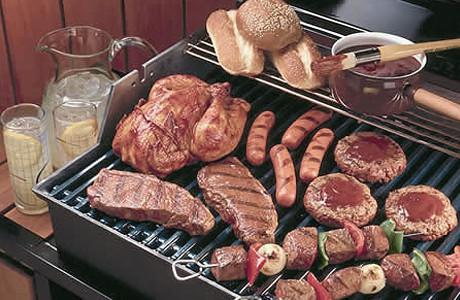
A short history of cooking meat on the fire
When they began to cook the meat on the fire, significantly difficult to say. According to recent data, human ancestors picked up guns and began to butcher and cut meat three million years ago, but only after a million years, they guessed it fires.
Beginning era of the first barbecue scientists have identified the remains of teeth of our ancestors. Just two million years ago we began to grow shallow teeth. And the reason for it - grilled meat, chew, which was much lighter and softer than raw, and assimilated it better. Primitive chefs originally threw carcasses and pieces into the fire, and then invented a kind of skewer.
Something like a shish kebab (ὀβελίσκος - obeliskos in ancient Greek) existed in Greece since the VIII century BC. e. - It is mentioned in the "Iliad" of Homer, in the works of Aristophanes and Aristotle.
In the course of excavations at Akrotiri on the Greek island of Santorini have been found stone barbecue sets and skewers, which were used in the XVII century BC. e. According to the records of the Moroccan traveler Ibn Battuta, during the Delhi Sultanate in India (1206-1526 BC. E.) Kebab served in the royal palace and in the homes of commoners, who even ate it for breakfast with bread, similar to pita bread.
Kebab (from Persian kabâb - grilled meat), or barbecue, appeared in the Middle East due to the scarcity of wood. For the preparation of whole carcasses or large pieces needed a lot of coal, and medieval Persian warriors get the hand to cut the meat and smaller string of frying on their swords.
To keep the heat and the convenience of cooking were created by the first barbecues (brazier in Arabic), which represents a wide copper bowl on legs.
Zazharivanie spit all sorts of game until the middle of the XVIII century was spread everywhere in Europe. In Russia, a festive dish from ancient times were considered "spinning" (ie, grilled on a skewer), pigs, chickens, ducks and rabbits. Incidentally, the word barbecue comes from the Turkic word "shish", also referred to spit.
American cowboys, in turn, grilled meat on wooden lattices probably podsmotrev this method the Indians and called it a "barbecue".
There are several theories about the origin of the word. According to one version, the Spanish explorers, first came to the Caribbean, were delighted with the fried goat, which the locals prepare high above the coals on a lattice of branches, called barbacoa.
Perhaps the word also comes from the French expression barbe à queue, which is in the culinary context can be interpreted as a way to fry the whole game, that is "from the beard to the tail."
In American folklore, there is another version: that the word dates back to the days when the roadside pubs with tables for pool were advertising signs «Bar, Beer and Cues» («Bar, beer and cues"). According to this bike, the phrase was first reduced to BBCue, and then to BBQ, and this became known as the abbreviation way of cooking meat, popular in the United States.
In pictures:
1. Men from the Arawak tribe, the indigenous population of the Caribbean islands, fried fish on a wooden lattice.
2. Flemish engraving of the XVII century with a woman who sells fries and grilled vegetables.
3. "National BBQ" in Texas in 1960 - the meat is fried on a lattice over the trench with coal.
4. Brush on canvas of the XVI century master from Bologna, depicting a scene frying bull.
5. Swatch Technologies 1960 - Electric instigators of coal, which resembles a large kettle.
6. American gas station 1920 where barbequing peacefully right next to gas stations.
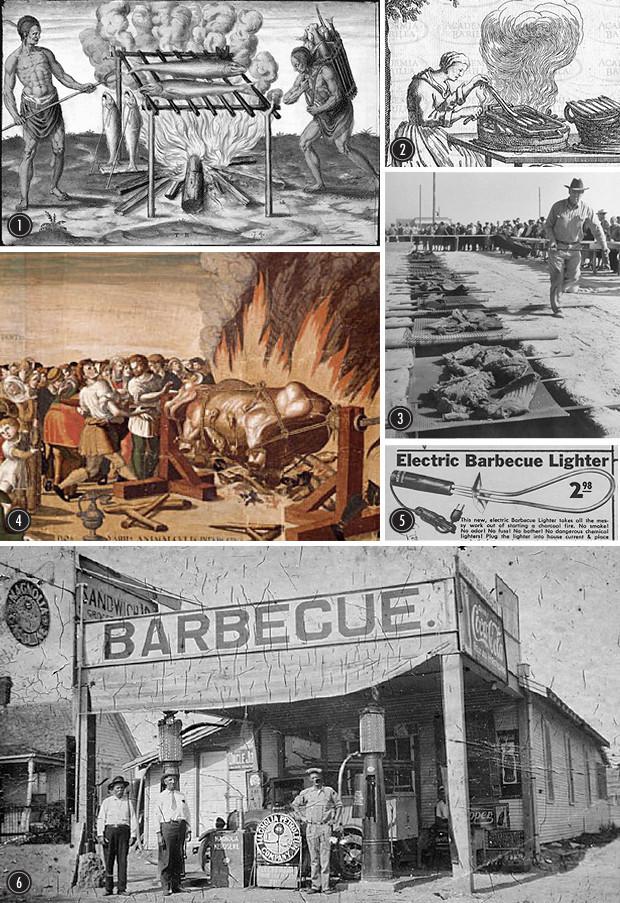
How to cook meat today worldwide
ASIA
The main ingredients: chicken, pork
Spices and seasonings: ginger, garlic, chili
What are prepared: roasted on skewers
Ingredients marinade: soy sauce, sugar
Korea
Korean version of barbecue called bulgogi. Thinly sliced beef (sometimes pork or chicken) is marinated in a mixture of soy sauce, sugar, sesame oil, garlic and chili pepper, then fried on a grill at the table. The dish is traditionally served with rice and kimchi (spicy pickled cabbage).
Bulgogi literally means "fire meat". Also in Korea prepared Galbi - fried pork or beef ribs marinated beforehand by the same recipe.

Japan
Yakitori (in Japanese "fried bird") - Japanese skewers of chicken meat or viscera, roasted over the coals on bamboo sticks.
Yakitori sauce poured tare, which is made of mirin (sweet rice wine really), sake, soy sauce and sugar and fry until cooked, then served with a gravy of sauce, salt and lemon.
Similarly, fried pork, beef, fish and seafood. While in Japan, these kinds of barbecue called kusiyaki, in other countries, they are also often called yakitori.
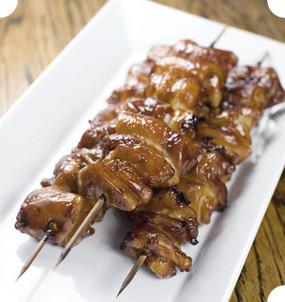
China
In the southern provinces of China and Hong Kong are preparing spells Sioux - pork, grilled on charcoal. First, long strips of pork tenderloin marinated in a mixture of honey, anise, cloves, cinnamon, Sichuan pepper and fennel seeds, red fermented bean curd (hóngfǔrǔ), soy sauce, sherry or rice wine. Then each piece of pork roasts his himself, so the process is more like fondue than a Western-style barbecue.
Southeast Asia
Cate (or satay) - kebabs from South-East Asia: Malaysia, Singapore, Indonesia and Thailand. They consist of a threaded on bamboo skewers small pieces of meat marinated in a mixture of garlic, ginger, sugar, soy sauce, lime juice, sesame oil, coriander, turmeric and chili.
Apart from the traditional chicken, lamb, beef and goat meat, satay made from vegetables, tofu and seafood.
Outside the Muslim enclaves are also prepared pork and offal. It prepared kebabs served thick sauce of crushed peanuts, peanut butter and coconut milk and spices.

INDIA
The main ingredients: chicken
Spices and condiments: cardamom, cinnamon, turmeric, nutmeg
What are prepared: roasted on the grill and skewer
Ingredients marinade: yogurt, vegetable oil
Chicken tikka - a traditional dish of Indian cuisine, which is a small marinated pieces of chicken fillet, baked in the tandoor, or roasted over charcoal. The marinade consists of a mixture of crushed cardamom, cinnamon, cloves, black pepper, nutmeg, ginger, yogurt, vegetable oil and sugar.
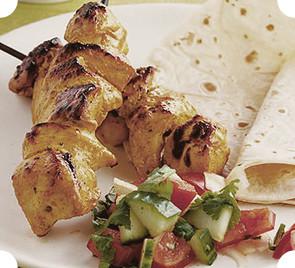
AUSTRALIA
Main ingredients: seafood, beef
Spices and condiments: Worcestershire sauce
What are prepared: grilled
Ingredients marinade: tropical fruit puree
In Australia, grilled steaks grilled American style seafood (large shrimp, lobster tails), as well as local delicacies - ostrich and kangaroo meat.
Meat is often a pre-marinated Using mashed papaya or kiwi fruit with dry wine, Worcestershire sauce, mustard, onion, garlic and pepper.
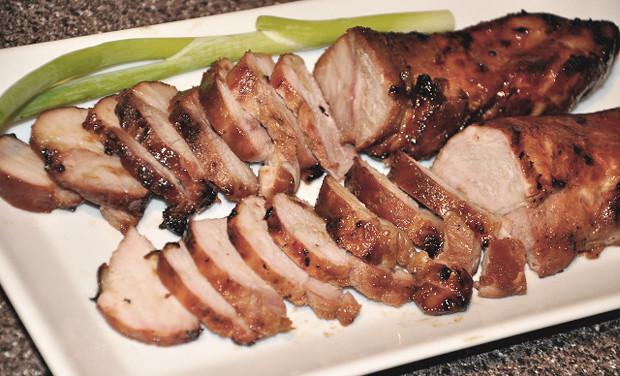
EUROPE
Key Ingredients: pork, beef
Spices and condiments: rosemary, juniper berries, greens
What are prepared: grilled
Ingredients marinade: olive oil, mustard
Germany
German Grill difficult to imagine without the constant local sausages and marinated pork steaks from the blade. To prepare the marinade for the so-called shvenkbraten need vegetable oil, juniper berries, German mustard, paprika, black pepper, onion, garlic, sage, rosemary, thyme and parsley leaves.
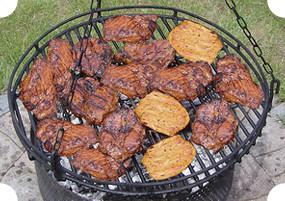
Britain
Barbecue in the UK is a mix of American, German, Scandinavian and Mediterranean traditions. The most common ingredients - a chicken, hamburgers, hot dogs, steaks, kebabs. Meat, as in the US, poured sauce during cooking. On the grid are also squash, potatoes, asparagus and beets.
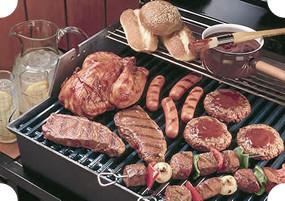
US
Main ingredients: beef, chicken
Spices and condiments: mustard, chili
What are prepared: grilled
Ingredients marinade: tomato juice, vinegar
American settlers, borrowing a method of frying meat from the Indians, developed out of it a cult.
The first experiments began in the second half of the XVIII century, when meat became lubricated with a mixture of oil, salt and water. At the beginning of the XIX century it was invented the first sauces butter, wine, mushrooms and chestnuts.
Today, in different states under different barbecue residents understand. For example, in Memphis - is the pork ribs and sandwiches with minced pork and Cole Slaw, Texas - beef brisket. Residents of Santa Maria (CA) under the barbecue beef tenderloin imply tri-tip, and Decatur (Alabama) mean grilled smoked chicken with white sauce.
Sauces based on vinegar are more typical of the south-eastern states, and tomato-based sauces - for the Midwest and Western United States. But in general, for typical American barbecue that in most cases the meat is brought to readiness slowly over low heat (low and slow), and when a large amount of smoke.

LATIN AMERICA
Main ingredients: beef
Spices and seasonings: chili, paprika, garlic
What are prepared: large pieces fried on a lattice and long skewers
Ingredients marinade: citrus juice, olive oil
Asado - Appliances Cooking pieces of meat, usually beef, which are roasted on a grill (parrilla) or open fire. The dish is considered traditional for Latin America.
In Argentina, Paraguay and Uruguay asado cooked in two ways: al disco - using a grill made of the disk used by the old plow, and al Horno de Barro - in a traditional clay oven adapted for frying meat.
Carne Asada (literally "grilled meat") - Mexican dish of thinly sliced beef, rubbed with olive oil, salt, lemon, pepper, garlic and grilled. Meat can be served alone or sliced and used in tacos, burritos or quesadillas. Carne Asada is often served with fresh guacamole, fried onions, beans and salsa.
Cabrito - also a popular Mexican dish, which is a whole eviscerated goat roasted on the fire.
Churrasco - Portuguese and Spanish term for the meat (usually beef) from the grill. Particularly important dish in the kitchen occupies Argentina, Brazil, Chile, Nicaragua and Uruguay. The pieces of meat before frying rubbed with salt, olive oil, black pepper, chili and paprika, or marinated in orange juice, garlic, salt and pepper.
Restaurants-churaskerii usually work on the principle of "you-can-eat": passadores (chef and he's a waiter) cuts off the guest churrasco strip as long as he will not be sated. This method of feeding called Rodizio.
Jamaica
In Jamaica, there is a tradition of cooking air-cured and smoked meats on a slowly smoldering fragrant wood. Goat, chicken or pork is rubbed with a mixture of burning fragrant pepper, pimento called the island "and peppers" Scotch Bonnet ", which belongs to the most acute in the world. A leisurely way to prepare organically combined with the relaxed way of life of local people.
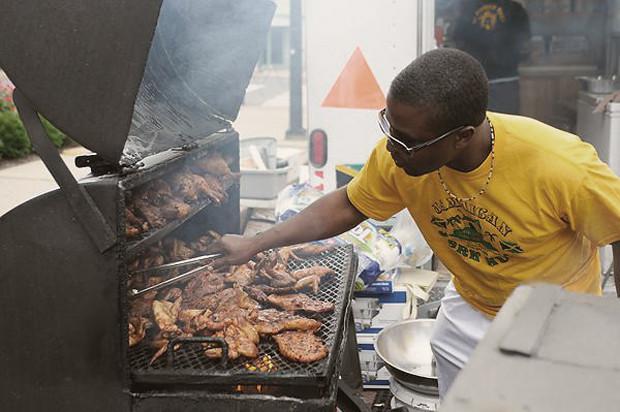
MIDDLE EAST AND THE CAUCASUS
Main ingredients: lamb
Spices and condiments: coriander, cumin, thyme, parsley
What are prepared: grilled on skewers on the grill
Ingredients marinade: dairy products, lemon juice
Middle East
Shish-tauk - Arabic skewers of chicken, which is prepared in Lebanon, Egypt, Syria, Iraq and other countries. Poultry marinade recipes vary, but basically have the yogurt, tomato paste, olive oil and lemon juice. Also add the thyme, cinnamon, coriander, garlic and pepper.
Kebab - pieces of meat roasted on a skewer. This dish is prepared in the Caucasus, the Middle East and the Balkans lamb, milled with onions. To lula do not fall apart, minced meat is kneaded for a long time to give it a smooth consistency.
Kebab Aleppo - a very common dish in Syria and Lebanon. Similarity kebab served with a spicy tomato sauce and pepper Aleppo. One of its variants is a semblance of lamb meatballs with a thick spicy cherry sauce and pine nuts.
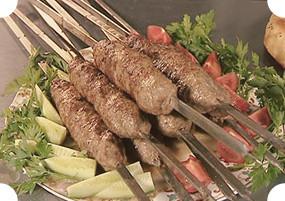
Caucasus
Each Caucasian nation barbecue is called differently and preparing their national characteristics. The Azeri kebab skewers referred, in Georgia it is called mtsvadi in Armenia khorovats in fizonag Ossetia.
Traditionally made from pork loin skewers (dorsal part of the lamb), hind leg of lamb carcasses, fins, liver, heart, kidney and fat tail (fat deposits in the area of the tail).
Among the common and traditional foundations marinade meat found wine, vinegar, milk products (yogurt, kefir, etc.), pomegranate, lemon and other acidic juices.
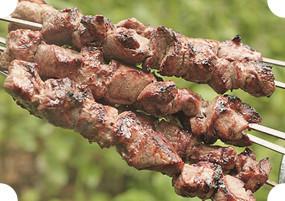
How to choose a fresh and young meat?
Look
Carefully read the section of the piece. Do lamb and beef, he should have a smooth glossy red color, from pork - pink. Fat should be white or light yellow. Dark meat with bright yellow fat clearly belonged to an old animal and frying will taste like sole. Pay attention to the fiber, if they are dense and thick, meat also get a solid.
Feel
The piece should be moderately elastic and rather soft. If pressing a finger dent disappears after a while - the meat tender and mature if the mark remains - perhaps defrosted meat. If a piece of "spring" - means a fresh cut, but when frying may be rubber. Meat juices should be clear - if he has a red tint, chances are you are trying to sell a piece of defrosted.
Smell
His scent should not cause unpleasant sensations: your animal instincts will see if the meat is on the counter too long ago. If the steam pork can be cooked at once, steam beef and mutton is not suitable for frying - the meat will be harsh. It is better to give preference to sustain meat - muscles of the animal must be completely relaxed.
What part choose?
PORK
The best part for frying in pork - this neck of pork, located along the ridge on the neck of the animal. This meat characterized in that the fat streaks uniformly distributed therein. Barbecue meat as will fit along the ridge on the back, but the lean meat from the back side is not worth taking, otherwise the dish will turn out dry and tough.
LAMB
Lamb kebabs - a classic of the genre. It is best to cook it fit flesh back, loin, ribs and brisket. For roasting on the fire and will fit leg of lamb.
BEEF
When choosing beef need to be especially careful - this is the most insidious meat for shish kebab. Looking for the right piece, should pay attention to a cutting or loin part. The hind leg is suitable for cooking, not all, but only its inner part and some places thick and thin edges. The main thing that beef was younger, and it is best if it's beef.
CHICKEN
Chicken is suitable for frying its entirety, including its internal organs (kidney, stomach and so on. D.). Choosing frying chicken legs, experienced cooks advise is better to take the left leg. The right leg of chicken supposedly working on her chicken often is, therefore left the meat should be tender.
Posted in [mergetime] 1336937830 [/ mergetime]
HOW chopped?
Size of cutting meat for barbecue depends on what part of the carcass this piece belonged to and how it will marinate. The tender meat marinade and stronger, the larger pieces can be. But as a rule, the ideal piece for a rotisserie options 5h5h5 cm and weight less than 70 grams. When harvesting steaks important that Reza meat across the grain, rather than along. Marinade
Originally it served as a simple marinade sea water, preserve meat and fish from spoiling, and the name "pickle" is derived from the Latin word marina (Marine).
Ancient cooks quickly realized that when marinating meat taste and its texture improves. Recipes marinades become complicated: in the course went vinegar, milk products, fruit juices and wine. The acids contained in these liquids, destroying the fibers soften and rigid pieces of meat. Also began to add various oils that retain juiciness and greens, onion, garlic and a variety of spices that give zest to the meat and flavor.
In fact, the marinade - a matter of taste.
Source:
Past May Day celebrations at last opened the season picnic and holiday pilgrimage, and with it, and cooking meat outdoors. Now, every weekend there will inevitably be accompanied by mass migration to suburban forest belts, smoke smelling clothes and indispensable reflection about the choice of a suitable meat, barbecue and firewood.
To make it easier to navigate in this difficult matter gastronomic, here you will learn about the history and methods of cooking meat in different countries, and also gives some practical advice on how to choose and marinate the meat for a shish kebab and a barbecue.

A short history of cooking meat on the fire
When they began to cook the meat on the fire, significantly difficult to say. According to recent data, human ancestors picked up guns and began to butcher and cut meat three million years ago, but only after a million years, they guessed it fires.
Beginning era of the first barbecue scientists have identified the remains of teeth of our ancestors. Just two million years ago we began to grow shallow teeth. And the reason for it - grilled meat, chew, which was much lighter and softer than raw, and assimilated it better. Primitive chefs originally threw carcasses and pieces into the fire, and then invented a kind of skewer.
Something like a shish kebab (ὀβελίσκος - obeliskos in ancient Greek) existed in Greece since the VIII century BC. e. - It is mentioned in the "Iliad" of Homer, in the works of Aristophanes and Aristotle.
In the course of excavations at Akrotiri on the Greek island of Santorini have been found stone barbecue sets and skewers, which were used in the XVII century BC. e. According to the records of the Moroccan traveler Ibn Battuta, during the Delhi Sultanate in India (1206-1526 BC. E.) Kebab served in the royal palace and in the homes of commoners, who even ate it for breakfast with bread, similar to pita bread.
Kebab (from Persian kabâb - grilled meat), or barbecue, appeared in the Middle East due to the scarcity of wood. For the preparation of whole carcasses or large pieces needed a lot of coal, and medieval Persian warriors get the hand to cut the meat and smaller string of frying on their swords.
To keep the heat and the convenience of cooking were created by the first barbecues (brazier in Arabic), which represents a wide copper bowl on legs.
Zazharivanie spit all sorts of game until the middle of the XVIII century was spread everywhere in Europe. In Russia, a festive dish from ancient times were considered "spinning" (ie, grilled on a skewer), pigs, chickens, ducks and rabbits. Incidentally, the word barbecue comes from the Turkic word "shish", also referred to spit.
American cowboys, in turn, grilled meat on wooden lattices probably podsmotrev this method the Indians and called it a "barbecue".
There are several theories about the origin of the word. According to one version, the Spanish explorers, first came to the Caribbean, were delighted with the fried goat, which the locals prepare high above the coals on a lattice of branches, called barbacoa.
Perhaps the word also comes from the French expression barbe à queue, which is in the culinary context can be interpreted as a way to fry the whole game, that is "from the beard to the tail."
In American folklore, there is another version: that the word dates back to the days when the roadside pubs with tables for pool were advertising signs «Bar, Beer and Cues» («Bar, beer and cues"). According to this bike, the phrase was first reduced to BBCue, and then to BBQ, and this became known as the abbreviation way of cooking meat, popular in the United States.
In pictures:
1. Men from the Arawak tribe, the indigenous population of the Caribbean islands, fried fish on a wooden lattice.
2. Flemish engraving of the XVII century with a woman who sells fries and grilled vegetables.
3. "National BBQ" in Texas in 1960 - the meat is fried on a lattice over the trench with coal.
4. Brush on canvas of the XVI century master from Bologna, depicting a scene frying bull.
5. Swatch Technologies 1960 - Electric instigators of coal, which resembles a large kettle.
6. American gas station 1920 where barbequing peacefully right next to gas stations.

How to cook meat today worldwide
ASIA
The main ingredients: chicken, pork
Spices and seasonings: ginger, garlic, chili
What are prepared: roasted on skewers
Ingredients marinade: soy sauce, sugar
Korea
Korean version of barbecue called bulgogi. Thinly sliced beef (sometimes pork or chicken) is marinated in a mixture of soy sauce, sugar, sesame oil, garlic and chili pepper, then fried on a grill at the table. The dish is traditionally served with rice and kimchi (spicy pickled cabbage).
Bulgogi literally means "fire meat". Also in Korea prepared Galbi - fried pork or beef ribs marinated beforehand by the same recipe.

Japan
Yakitori (in Japanese "fried bird") - Japanese skewers of chicken meat or viscera, roasted over the coals on bamboo sticks.
Yakitori sauce poured tare, which is made of mirin (sweet rice wine really), sake, soy sauce and sugar and fry until cooked, then served with a gravy of sauce, salt and lemon.
Similarly, fried pork, beef, fish and seafood. While in Japan, these kinds of barbecue called kusiyaki, in other countries, they are also often called yakitori.

China
In the southern provinces of China and Hong Kong are preparing spells Sioux - pork, grilled on charcoal. First, long strips of pork tenderloin marinated in a mixture of honey, anise, cloves, cinnamon, Sichuan pepper and fennel seeds, red fermented bean curd (hóngfǔrǔ), soy sauce, sherry or rice wine. Then each piece of pork roasts his himself, so the process is more like fondue than a Western-style barbecue.
Southeast Asia
Cate (or satay) - kebabs from South-East Asia: Malaysia, Singapore, Indonesia and Thailand. They consist of a threaded on bamboo skewers small pieces of meat marinated in a mixture of garlic, ginger, sugar, soy sauce, lime juice, sesame oil, coriander, turmeric and chili.
Apart from the traditional chicken, lamb, beef and goat meat, satay made from vegetables, tofu and seafood.
Outside the Muslim enclaves are also prepared pork and offal. It prepared kebabs served thick sauce of crushed peanuts, peanut butter and coconut milk and spices.

INDIA
The main ingredients: chicken
Spices and condiments: cardamom, cinnamon, turmeric, nutmeg
What are prepared: roasted on the grill and skewer
Ingredients marinade: yogurt, vegetable oil
Chicken tikka - a traditional dish of Indian cuisine, which is a small marinated pieces of chicken fillet, baked in the tandoor, or roasted over charcoal. The marinade consists of a mixture of crushed cardamom, cinnamon, cloves, black pepper, nutmeg, ginger, yogurt, vegetable oil and sugar.

AUSTRALIA
Main ingredients: seafood, beef
Spices and condiments: Worcestershire sauce
What are prepared: grilled
Ingredients marinade: tropical fruit puree
In Australia, grilled steaks grilled American style seafood (large shrimp, lobster tails), as well as local delicacies - ostrich and kangaroo meat.
Meat is often a pre-marinated Using mashed papaya or kiwi fruit with dry wine, Worcestershire sauce, mustard, onion, garlic and pepper.

EUROPE
Key Ingredients: pork, beef
Spices and condiments: rosemary, juniper berries, greens
What are prepared: grilled
Ingredients marinade: olive oil, mustard
Germany
German Grill difficult to imagine without the constant local sausages and marinated pork steaks from the blade. To prepare the marinade for the so-called shvenkbraten need vegetable oil, juniper berries, German mustard, paprika, black pepper, onion, garlic, sage, rosemary, thyme and parsley leaves.

Britain
Barbecue in the UK is a mix of American, German, Scandinavian and Mediterranean traditions. The most common ingredients - a chicken, hamburgers, hot dogs, steaks, kebabs. Meat, as in the US, poured sauce during cooking. On the grid are also squash, potatoes, asparagus and beets.

US
Main ingredients: beef, chicken
Spices and condiments: mustard, chili
What are prepared: grilled
Ingredients marinade: tomato juice, vinegar
American settlers, borrowing a method of frying meat from the Indians, developed out of it a cult.
The first experiments began in the second half of the XVIII century, when meat became lubricated with a mixture of oil, salt and water. At the beginning of the XIX century it was invented the first sauces butter, wine, mushrooms and chestnuts.
Today, in different states under different barbecue residents understand. For example, in Memphis - is the pork ribs and sandwiches with minced pork and Cole Slaw, Texas - beef brisket. Residents of Santa Maria (CA) under the barbecue beef tenderloin imply tri-tip, and Decatur (Alabama) mean grilled smoked chicken with white sauce.
Sauces based on vinegar are more typical of the south-eastern states, and tomato-based sauces - for the Midwest and Western United States. But in general, for typical American barbecue that in most cases the meat is brought to readiness slowly over low heat (low and slow), and when a large amount of smoke.

LATIN AMERICA
Main ingredients: beef
Spices and seasonings: chili, paprika, garlic
What are prepared: large pieces fried on a lattice and long skewers
Ingredients marinade: citrus juice, olive oil
Asado - Appliances Cooking pieces of meat, usually beef, which are roasted on a grill (parrilla) or open fire. The dish is considered traditional for Latin America.
In Argentina, Paraguay and Uruguay asado cooked in two ways: al disco - using a grill made of the disk used by the old plow, and al Horno de Barro - in a traditional clay oven adapted for frying meat.
Carne Asada (literally "grilled meat") - Mexican dish of thinly sliced beef, rubbed with olive oil, salt, lemon, pepper, garlic and grilled. Meat can be served alone or sliced and used in tacos, burritos or quesadillas. Carne Asada is often served with fresh guacamole, fried onions, beans and salsa.
Cabrito - also a popular Mexican dish, which is a whole eviscerated goat roasted on the fire.
Churrasco - Portuguese and Spanish term for the meat (usually beef) from the grill. Particularly important dish in the kitchen occupies Argentina, Brazil, Chile, Nicaragua and Uruguay. The pieces of meat before frying rubbed with salt, olive oil, black pepper, chili and paprika, or marinated in orange juice, garlic, salt and pepper.
Restaurants-churaskerii usually work on the principle of "you-can-eat": passadores (chef and he's a waiter) cuts off the guest churrasco strip as long as he will not be sated. This method of feeding called Rodizio.
Jamaica
In Jamaica, there is a tradition of cooking air-cured and smoked meats on a slowly smoldering fragrant wood. Goat, chicken or pork is rubbed with a mixture of burning fragrant pepper, pimento called the island "and peppers" Scotch Bonnet ", which belongs to the most acute in the world. A leisurely way to prepare organically combined with the relaxed way of life of local people.

MIDDLE EAST AND THE CAUCASUS
Main ingredients: lamb
Spices and condiments: coriander, cumin, thyme, parsley
What are prepared: grilled on skewers on the grill
Ingredients marinade: dairy products, lemon juice
Middle East
Shish-tauk - Arabic skewers of chicken, which is prepared in Lebanon, Egypt, Syria, Iraq and other countries. Poultry marinade recipes vary, but basically have the yogurt, tomato paste, olive oil and lemon juice. Also add the thyme, cinnamon, coriander, garlic and pepper.
Kebab - pieces of meat roasted on a skewer. This dish is prepared in the Caucasus, the Middle East and the Balkans lamb, milled with onions. To lula do not fall apart, minced meat is kneaded for a long time to give it a smooth consistency.
Kebab Aleppo - a very common dish in Syria and Lebanon. Similarity kebab served with a spicy tomato sauce and pepper Aleppo. One of its variants is a semblance of lamb meatballs with a thick spicy cherry sauce and pine nuts.

Caucasus
Each Caucasian nation barbecue is called differently and preparing their national characteristics. The Azeri kebab skewers referred, in Georgia it is called mtsvadi in Armenia khorovats in fizonag Ossetia.
Traditionally made from pork loin skewers (dorsal part of the lamb), hind leg of lamb carcasses, fins, liver, heart, kidney and fat tail (fat deposits in the area of the tail).
Among the common and traditional foundations marinade meat found wine, vinegar, milk products (yogurt, kefir, etc.), pomegranate, lemon and other acidic juices.

How to choose a fresh and young meat?
Look
Carefully read the section of the piece. Do lamb and beef, he should have a smooth glossy red color, from pork - pink. Fat should be white or light yellow. Dark meat with bright yellow fat clearly belonged to an old animal and frying will taste like sole. Pay attention to the fiber, if they are dense and thick, meat also get a solid.
Feel
The piece should be moderately elastic and rather soft. If pressing a finger dent disappears after a while - the meat tender and mature if the mark remains - perhaps defrosted meat. If a piece of "spring" - means a fresh cut, but when frying may be rubber. Meat juices should be clear - if he has a red tint, chances are you are trying to sell a piece of defrosted.
Smell
His scent should not cause unpleasant sensations: your animal instincts will see if the meat is on the counter too long ago. If the steam pork can be cooked at once, steam beef and mutton is not suitable for frying - the meat will be harsh. It is better to give preference to sustain meat - muscles of the animal must be completely relaxed.
What part choose?
PORK
The best part for frying in pork - this neck of pork, located along the ridge on the neck of the animal. This meat characterized in that the fat streaks uniformly distributed therein. Barbecue meat as will fit along the ridge on the back, but the lean meat from the back side is not worth taking, otherwise the dish will turn out dry and tough.
LAMB
Lamb kebabs - a classic of the genre. It is best to cook it fit flesh back, loin, ribs and brisket. For roasting on the fire and will fit leg of lamb.
BEEF
When choosing beef need to be especially careful - this is the most insidious meat for shish kebab. Looking for the right piece, should pay attention to a cutting or loin part. The hind leg is suitable for cooking, not all, but only its inner part and some places thick and thin edges. The main thing that beef was younger, and it is best if it's beef.
CHICKEN
Chicken is suitable for frying its entirety, including its internal organs (kidney, stomach and so on. D.). Choosing frying chicken legs, experienced cooks advise is better to take the left leg. The right leg of chicken supposedly working on her chicken often is, therefore left the meat should be tender.
Posted in [mergetime] 1336937830 [/ mergetime]
HOW chopped?
Size of cutting meat for barbecue depends on what part of the carcass this piece belonged to and how it will marinate. The tender meat marinade and stronger, the larger pieces can be. But as a rule, the ideal piece for a rotisserie options 5h5h5 cm and weight less than 70 grams. When harvesting steaks important that Reza meat across the grain, rather than along. Marinade
Originally it served as a simple marinade sea water, preserve meat and fish from spoiling, and the name "pickle" is derived from the Latin word marina (Marine).
Ancient cooks quickly realized that when marinating meat taste and its texture improves. Recipes marinades become complicated: in the course went vinegar, milk products, fruit juices and wine. The acids contained in these liquids, destroying the fibers soften and rigid pieces of meat. Also began to add various oils that retain juiciness and greens, onion, garlic and a variety of spices that give zest to the meat and flavor.
In fact, the marinade - a matter of taste.
Source:
Present your own hands
Woman police officer was killed in a traffic accident in the south-west of Moscow
